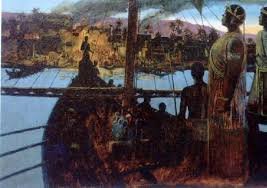Continued from previous post
Her full title was Amnirense qore li kdwe li (“Ameniras, qore and kandake”). Meroitic, the indigenous language of the kingdom of Kush, remains undeciphered; however, inscriptions giving Queen Amanirenas the title of “qore” as well as “kandake” suggest that she was an individually ruling queen.
Queen Amanirenas is one of the most famous Meroitic queens because of her role in leading the Kushite army against the Romans in a war that lasted three years (25 BC to 22 BC). This war is largely responsible for halting Rome’s southward expansion in Africa. After an initial victory against Roman Egypt, Prefect Gaius Petronius drove the Kushite army from Egypt and established a new Roman frontier at Hiere Sycaminos (Maharraqa).

Amanirenas’ Resistance Leads to Gains for Her Kingdom
While Strabo’s account casts the Romans in a victorious light, the outcome of the war suggests otherwise. By the beginning of 21 B.C., both armies were exhausted. Amanirenas sent emissaries to Samos to negotiate with Augustus, where he granted Amanirenas two important concessions. The first was the cancellation of the tax on the Meroë, the second was that Roman occupation would withdraw from the Second Cataract (around Gemai) to Maharaqqa, almost back on the border of Egypt.
While the details of this treaty are unclear, evidence suggests that Amanirenas’ resistance led to gains for her kingdom—despite any military losses. Lower Nubia had been a highly contested area well before the Roman and Greek occupations of Egypt. Nubian and Egyptian kingdoms had expanded and contracted over centuries as they fought for control of precious metals, animals, and slaves in the area. The re-establishment of Meroitic dominance in lower Nubia indicates a successful outcome for the kingdom of Meroë.

Although Kingdoms of Kush would eventually weaken and become absorbed into the Roman Empire, Amanirenas’ gains against Roman forces sealed her legacy as one of the few historical figures who resisted Roman rule.
Amanirenas (also spelled Amanirena), was queen regnant of the Kingdom of Kush from the end of the 1st century BCE to beginning of the 1st century CE. She is known for invading Roman occupied Egypt and successfully negotiating the end of Roman retaliation, retaining Kushite independence.
Strabo’s account of the Meroitic war led against the Roman Empire includes a queen named Kandakê (usually Latinized as Candace). Her name appears on stelae alongside those of Teriteqas and Akinidad, but the precise relationship between these three is not entirely clear in the historical record; however, scholars generally consider Akinidad to be her son and Teriteqas to be her husband, whilst kandake is her title.

Kushite Invasion of Egypt
Interestingly, according to Strabo’s account, Queen Amanirenas was blind in one eye.
Under her leadership, the Kushite forces launched an attack on Thebais and Syene while then-prefect of the Roman Army, Aelius Gallus was away on his ill-fated expedition to Arabia in 25 BC. They were successful in taking Syene, Elephantine, and Philae. As they took the city, they enslaved inhabitants and destroyed the statues of Caesar Augustus. Though Strabo does not mention it specifically, the head of one such statue was buried beneath the steps of a temple (the Meroë Head, see also below), resulting in its unique preservation. The bust remained intact throughout the centuries and is now displayed at the British Museum.
Strabo claims Gaius Petronius, the new prefect of Egypt, marched with “less than ten thousand infantry and eight hundred cavalry” against thirty thousand Kushite men in Syene. The Kushites fought with “large, oblong shields made of raw ox-hide” and simple weaponry such as axes, pikes, and swords. Because of this, they were overwhelmed by Petronius’ attack. Strabo describes the Kushite forces as “badly marshaled.”
The Kushite forces stated their invasion was due to an issue with the nomarchs, the provincial governors of Egypt; Strabo does not provide information on what the issue was. After Petronius’ victory, the Kushite army fled in various directions: some into the cities, some into the desert, and others onto a nearby island.

Strabo ascertains that “among these fugitives were the generals of Queen Candace”, queen of the Ethiopians. He describes her as “a masculine sort of woman, and blind in one eye.” Strabo is almost certainly referring to Amanirenas, who bore the title of kandake; “Candace” is a Latinization of her title and does not refer to a separate ruler. After capturing the fleeing forces, Petronius sent them to Alexandria to await judgment.
Amanirenas herself resided at Napata with her son. As Petronius approached, taking Pselchis and Premnis along the way, Amanirenas dispatched envoys and the message that she would return both the captives taken in Syene and the statues of Caesar. Her entreaty was ignored and the city was razed. Of the surviving captives he took, some were sold and others sent to Augustus as prisoners of war.
In response, Amanirenas led a second attack against the forces of Petronius left behind at Premnis. Strabo states she had “many thousands of men.” Petronius outmaneuvered Amanirenas and arrived at Premnis first, securing it against her attack. Amanirenas sent ambassadors, which Petronius had escorted to Augustus in Samos on his way to Syria. Augustus imposed no further tributes and fulfilled the ambassadors’ wishes.

After the success of Petronius’s Nubian campaign, the Roman Empire’s southern border moved beyond Egypt to Primis (Qasr Ibrim). The resulting peace treaty saw part of the Thirty-Mile Strip, including Primis, evacuated by the Romans. The Meroites were exempt from paying tribute to the Empire. The treaty allowed the Romans to continue to occupy the Dodekashoinos (“Twelve-Mile Lands”) as a military border zone. The Roman frontier was then moved near Hiere Sycaminos (Maharraqa).
This treaty remained active until the end of the third century AD, with relations between the Kushites and Roman Egypt remaining generally peaceful during this time. The kingdom of Kush remained a formidable power until its decline during the second century CE.
Stay tuned for more on the History of Africa’s Lionesses.




